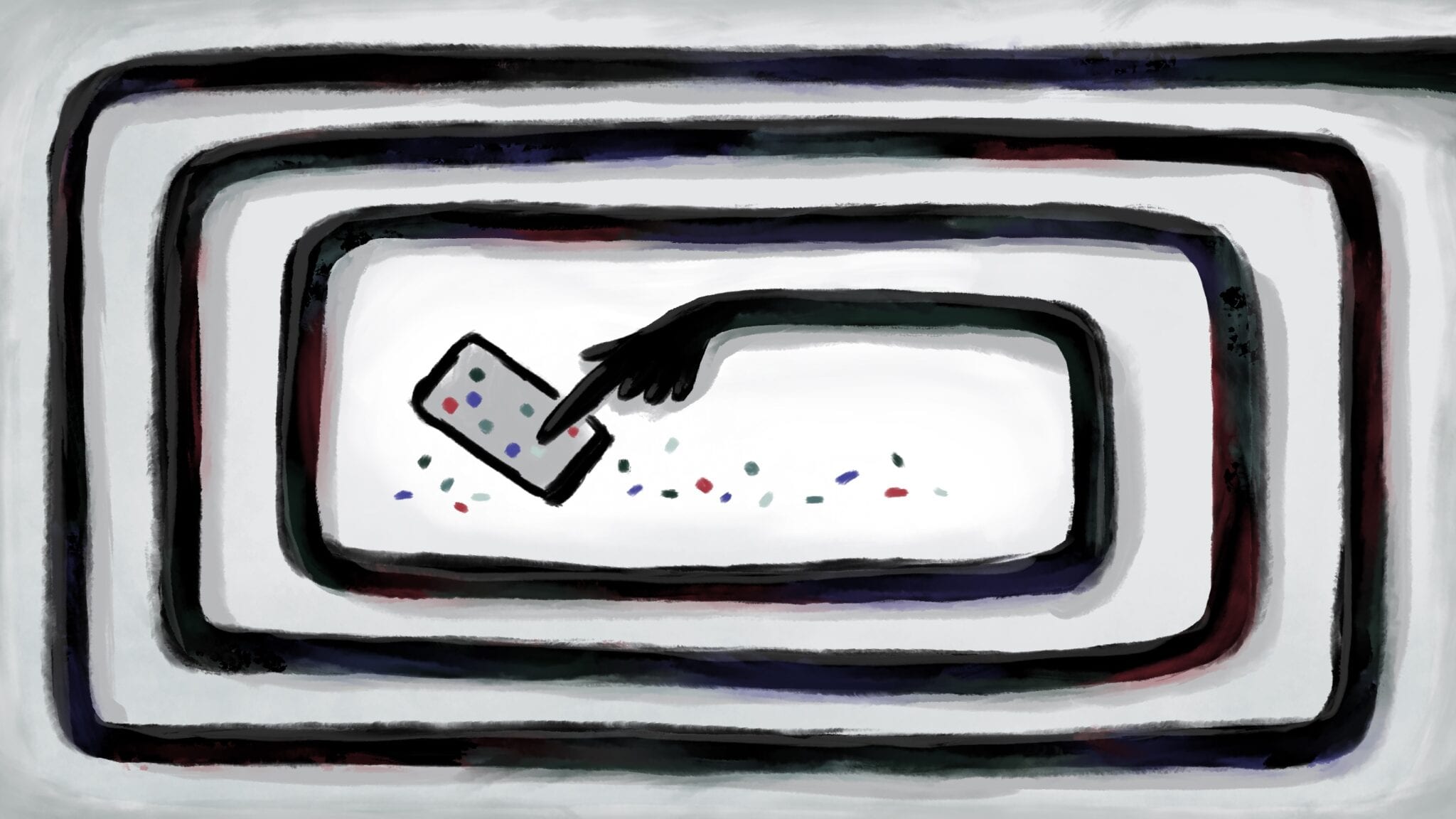8:00a
Cooking Podcast
9:30a
History of Opera course over Zoom
11:00a
FaceTime with best friend from childhood
1:00p
Text exchange with neighbor on the fourth floor
The schedule above seems normal enough for an ordinary, device-centric day in 2020. What makes it extraordinary is that it’s the schedule of a newly tech-enabled nonagenarian. Iris, 92, hungry for a simulacrum of in-person connection, was forced to become binary best friends with inanimate blocks of silicon and glass.

Her eyesight fading, she relies on voice assistants, learns motions and favorites productive workflows across a suite of apps and portfolio of devices. All seems passably normal until a standard tech ritual turns a planned podcast listening session into sheer panic: An overnight update renders all she’s learned useless. What’s new? Every button she knows is now a knob. Would you like to speak to your friend in a Kiwi-tinged accent? Blink twice and make a bird call towards the spinning orb.
What follows is most likely a familiar dynamic for most of us, one that has been explored in depth as part of Ketchum’s Technology Sandwich Generation study: a phone tree of children, grandchildren and frantic Twitter searches. Which setting pane, menu tweak or staring contest will allow Iris to get back to her regularly scheduled life?
As consumer technology shifts from novelty to necessity, there needs to be a corresponding shift to curb the restlessness of ship-and-fix culture. We need to give closer attention to the small actions that have a big impact on our new reality of living inside a massive interface of work, entertainment and overall connection.
How can we as communicators help tech companies evolve the good intentions for iterative design?
Form Follows Intention
Nearly 120 years ago, one method that allowed people to feel comfortable with the shifting scale of architecture was to make something new feel old and familiar.
The brilliant architect Louis Sullivan realized that making structures of ever-greater scale seem approachable and desirable meant considering the scale of the occupant and using familiar materials in novel ways. This new canon of design emphasized the verticality of a structure but framed the key interaction points with simplified yet classical forms. It was enough of the past to feel a connection to what came before, with a nudge toward the light-filled, well-ventilated spaces that would come to define the future.
Similarly, as we enter a new phase of augmented connection with our colleagues, family and friends, we should expect our device-driven environments to be functional, intuitive and joy-inducing.
As our apertures for experiencing so much of the lockdown-weary world, hardware and software must intuit specific emotions and allow for trust to be established between human and device. This process must start and end with a deeper understanding of our drive to explore and connect without frustration, finding reward and pleasure in the use of an object.
Interfaces for Life
So who is responsible for solving, building and evolving these interface-centric devices? The anthropologist? The customer experience team? The software developer? The interface designer? The MarComs specialist?
The answer, of course, is all of the above, and their challenge is that they must understand the true mission of the product. Should the device evolve in a linear way? Should it be a revolution in usability with each major update?
I’d argue that the age of leaps and bounds should be replaced with a view of graphical Darwinism—how interfaces retain similar forms while larger roadmaps for deeper interactions evolve over a longer timeframe. Instead of competing with each other, what if Big Tech competed for elevated levels of continued usability? That by avoiding annual change for the sake of a talking point—it was rooted in something much deeper? Something that is rooted in a more functional type of empathy for a wide range of ages/sight abilities and mobility requirements.
Thinking this way means our devices and interfaces can be informed by our actual use, abilities and requirements, molding or simplifying their purpose based on our interaction with them.
User Empathy
So, deep breath, let’s go back to Iris.
Yes, voice assistants and other assistive technologies have become slightly more sophisticated—but so often one evolution in an emotive sense results in a regression in another, often without warning after a seemingly innocuous overnight update. But I believe this process can be adapted for consumers of different ages or abilities, with elements being slow-walked into changing versus being lumped together in the all too familiar and out-of-context “What’s New?” modal box.
From a communications standpoint, those of us more familiar with introducing complex topics to a wide range of audiences can help ensure the march of technology continues, but with a greater context for its inevitable impact. Marketing and communications professionals, hardware/software engineers, specialists of human behavior and product managers can find a common ground where newness is replaced with the deepest sense of empathy.
To start, we need to channel the empathy of those trying to help Iris navigate her new world remotely. The empathy to keep her from having to relearn her mental roadmap of human interaction annually, as smart devices evolve from gadget to quasi-appendage. The empathy to view devices not only as tools, but as partners—and to expect from them the understanding and courtesy we expect of each other.
What do you think? How can this approach come to life in the service of connecting the world in a more functional and joy-inducing way? At Ketchum, we’re passionate about how design can better connect brands with humans—reach out if you’d like to continue the conversation.



